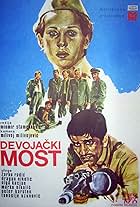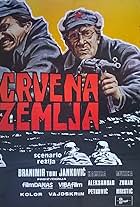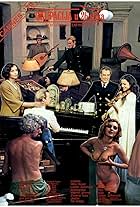Añade un argumento en tu idiomaThe Kragujevac Massacre in Serbia is described to a group of shoeshine boys. At that time, thousands of workers refused to work for the occupying Germans, and the whole city was exposed to h... Leer todoThe Kragujevac Massacre in Serbia is described to a group of shoeshine boys. At that time, thousands of workers refused to work for the occupying Germans, and the whole city was exposed to harsh repression and persecution and the abolition of the regular rations of food.The Kragujevac Massacre in Serbia is described to a group of shoeshine boys. At that time, thousands of workers refused to work for the occupying Germans, and the whole city was exposed to harsh repression and persecution and the abolition of the regular rations of food.
- Dirección
- Guión
- Reparto principal
- Premios
- 1 premio y 1 nominación en total
- Otto von Bischofshausen
- (as Vasilije Pantelic)
Reseñas destacadas
How accurate is the film? Was the Kragujevac Massacre precipitated by a Communist Partisan guerrilla attack against German troops?
This is how the U.S. Holocaust Memorial Museum describes the events that led up to the Kragujevac massacre: "In response to the capture of the 6th Company of the 920th Security (Landesschuetzen) Battalion by Cetnik resistance fighters in the town of Gorni Milanovac on 28 September 1941, the overall Wehrmacht commander in Serbia, General Franz Boehme, sent German troops to the area to carry out reprisal actions."
According to this account, it was Chetnik guerrillas under Draza Mihailovich that sparked the events that followed. The movie seeks to be politically correct and reflects the Communist orthodoxy or ideology or Party line, however, that it was only the Partisans that were engaged in guerrilla activity. As a movie made during the height of the Communist dictatorship of Josip Broz Tito, this type of falsification is to be expected. The most glaring inaccuracy is with regard to the time of year depicted in the movie. The actual Kragujevac massacre occurred in the fall, October 21, 1941. In the movie, however, the time of year appears to be spring or summer with the corn fields just planted. The German tanks used in the movie appear to be inaccurate historically. The Germans used the Panzerkampfwagen Mark III and captured French Somua S35 tanks in the Kragujevac region in 1941. The tanks and personnel carriers used in the film appear to be improvised types that are not historically accurate. The German personnel carriers, in particular, stand out as anachronistic and ones not used by German forces at that time or place. The German tanks appear to be U.S. M4 Sherman E4 series medium tanks with 76 mm guns produced in the early 1950s which the U.S. shipped to Yugoslavia after the 1948 Stalin-Tito split for use in the Yugoslav Army.
There are other problems of historical accuracy as well. Why would the Germans broadcast on the radio a speech by Adolf Hitler from the 1934 documentary Triumph of the Will? In German? Moreover, Rudolf Hess is heard following the Hitler speech. Hess, however, had flown to Scotland on May 10, 1941 and been captured in an unsuccessful attempt to recruit Britain as an ally before the German invasion of the USSR. Clearly, historical accuracy, verisimilitude, and cinema verite are not high priorities of the movie. The screenwriter Branimir Jankovic is not a historian and the research involved was not very thorough or extensive.
Were children executed? The Germans executed males between the ages of 16 to 60. In the movie, children under 16 are shown being executed. This was obviously for dramatic effect and to heighten the pathos and emotional impact.
How accurate is the number given of those killed at 8,000 men and boys? This number is obviously inaccurate and grossly inflated and was used by the Tito regime to hype up the massacre. The most recent determination of the number of persons killed in the massacre is 2,794 men shot, 415 in villages and 2,379 in the city of Kragujevac.
The movie is marred by the need to present the Communist Party line or historical orthodoxy on the events depicted. These instances are relatively brief in the movie. If one can overlook these intrusions, the movie works. The metaphor or theme of the movie is subservience or acquiescence to force or overwhelming power. Should one collaborate with the occupiers or should one resist? This is the overarching theme of the movie. The metaphor for this theme is the scene where German officers force the children to shine their shoes. The children choose defiance and resistance, choosing to die rather than to submit. On this level, the movie is successful in appealing to transcendent and universal human traits. Should one fight or should one submit? How do you respond to military occupation? Should one be a "traitor", "quisling", a "collaborator". Or should one resist and oppose force? In a movie, the choices are always easy or easier because actors do not die. They live to act in other movies. In real life, choices on whether to resist involve real consequences. Is it better to resist and to face death or is it better to endure occupation and oppression? One lives to fight another day. But most importantly, one lives, one survives. These can be difficult and controversial questions. But they are not ones that are presented only in movies and in fiction. These are universal human dilemmas that all people in any country and in any time can relate to. They are dilemmas that have always faced mankind and continue to do so. Can military occupation lead to peace and stability? In Afghanistan, Iraq, Kosovo, and Bosnia? These are issues that still are relevant because they represent fundamental and transcendent human values.
Argumento
¿Sabías que...?
- ConexionesFeatured in Como Me Apaixonei por Eva Ras (2016)
Selecciones populares
Detalles
- Duración1 hora 28 minutos
- Mezcla de sonido
- Relación de aspecto
- 1.66 : 1
Contribuir a esta página






















